Fujifilm Fujinon XF 55-200mm f/3.5-4.8 R LM OIS Lens Review
Fujifilm Fujinon XF 55-200mm f/3.5-4.8 R LM OIS Performance
At 55mm, sharpness in the centre of the frame at maximum aperture is already outstanding, with the clarity towards the edges falling just short of excellent. Stopping down to between f/4 and f/8 raises sharpness towards the edges to excellent levels, whilst maintaining outstanding clarity in the centre of the frame.Zooming to 100mm results in an overall reduction in sharpness across the frame. Still, sharpness is very good in the centre of the frame at maximum aperture and good towards the edges of the frame. Peak sharpness is achieved with the aperture stopped down to f/8 for this focal length. Here clarity is excellent across the frame.
Finally, at 200mm there is a further, slight reduction in clarity. At maximum aperture, sharpness approaches very good in the centre of the frame and is good towards the edges of the frame. Peak sharpness is again achieved at f/8. Here clarity in the centre falls just short of excellent and is very good towards the edges of the frame.
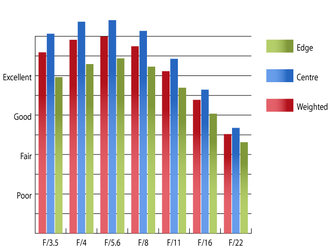 Resolution @ 55mm | 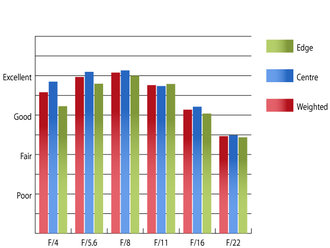 Resolution @ 100mm |
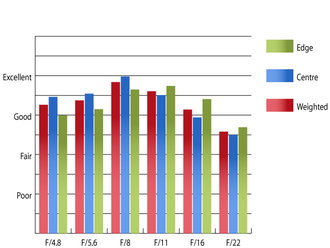 Resolution @ 200mm | How to read our chartsThe blue column represents readings from the centre of the picture frame at the various apertures and the green is from the edges. Averaging them out gives the red weighted column.The scale on the left side is an indication of actual image resolution. The taller the column, the better the lens performance. Simple. For this review, the lens was tested on a Fujifilm X-Pro1 using Imatest. |
Chromatic aberrations are very well controlled for a telephoto zoom lens with fringing only just exceeding half a pixel width towards the edges of the frame at 200mm and maximum aperture. This low level of fringing should pose few issues as it will be barely visible, even in large prints, or harsh crops from near the edges of the frame.
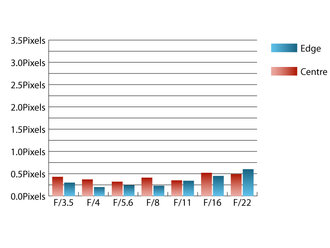 Chromatic aberration @ 55mm | 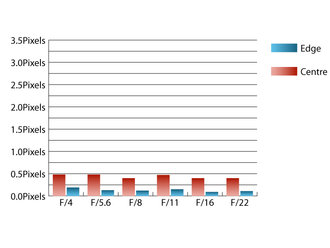 Chromatic aberration @ 100mm |
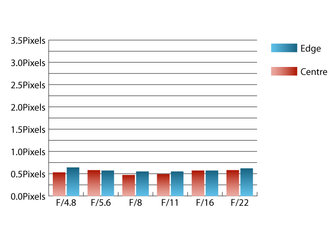 Chromatic aberration @ 200mm | How to read our chartsChromatic aberration is the lens' inability to focus on the sensor or film all colours of visible light at the same point. Severe chromatic aberration gives a noticeable fringing or a halo effect around sharp edges within the picture. It can be cured in software.Apochromatic lenses have special lens elements (aspheric, extra-low dispersion etc) to minimize the problem, hence they usually cost more. For this review, the lens was tested on a Fujifilm X-Pro1 using Imatest. |
Falloff of illumination towards the corners of the frame is pretty well controlled. At 55mm the corners are 1.5 stops darker than the image centre at maximum aperture, and at 200mm the corners are 1.9 stops darker. Visually uniform illumination is achieved by f/5.6 at 55mm and f/8 at 200mm.
A very slight amount of pincushion distortion is present throughout the zoom range. With only 0.2% pincushion distortion, this shouldn't be noticeable in normal picture taking. If absolutely straight lines are necessary, the distortion is quite simple to correct in image editing software afterwards as the distortion pattern is uniform across the frame.
Flare isn't much of an issue with this lens and contrast is retained well when shooting into the light, with or without a hood attached.
Add your message
Login required
Please login here or if you've not registered, you can register here. Registering is safe, quick and free.
Please login here or if you've not registered, you can register here. Registering is safe, quick and free.
photodo Stats
1102 lenses
428 MTF tests
74 in-depth photodo reviews
100+ users join each day
Help the lens community by reviewing or rating a lens today via our lens search
428 MTF tests
74 in-depth photodo reviews
100+ users join each day
Help the lens community by reviewing or rating a lens today via our lens search
Latest Lens Reviews
- Chinon 28mm f/2.8 Vintage Lens Review
- Canon EF 70-200mm f/4L IS II USM Lens Review
- Samyang AF 85mm f/1.4 EF Review
- Sigma 70mm f/2.8 DG Macro Art Review
- Samyang AF 24mm f/2.8 FE Review
- Meike 50mm f/1.7 Review
- Tamron 70-210mm f/4 Di VC USD Review
- Lensbaby Burnside 35mm f/2.8 Review
- Asahi Super Takumar 50mm f/1.4 Review
- Asahi Super-Multi-Coated Takumar 135mm f/3.5 Review
